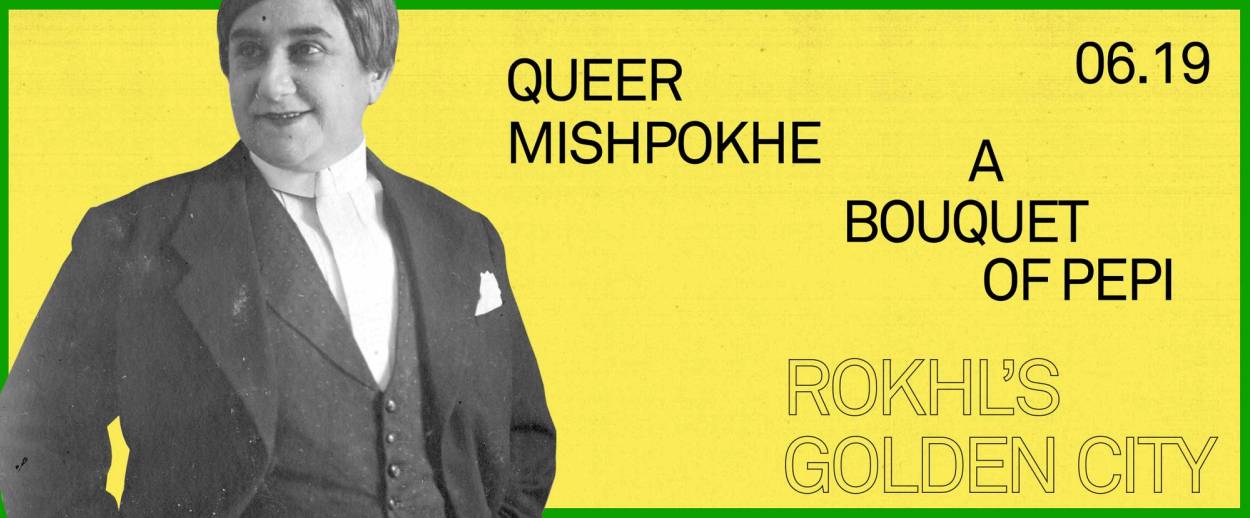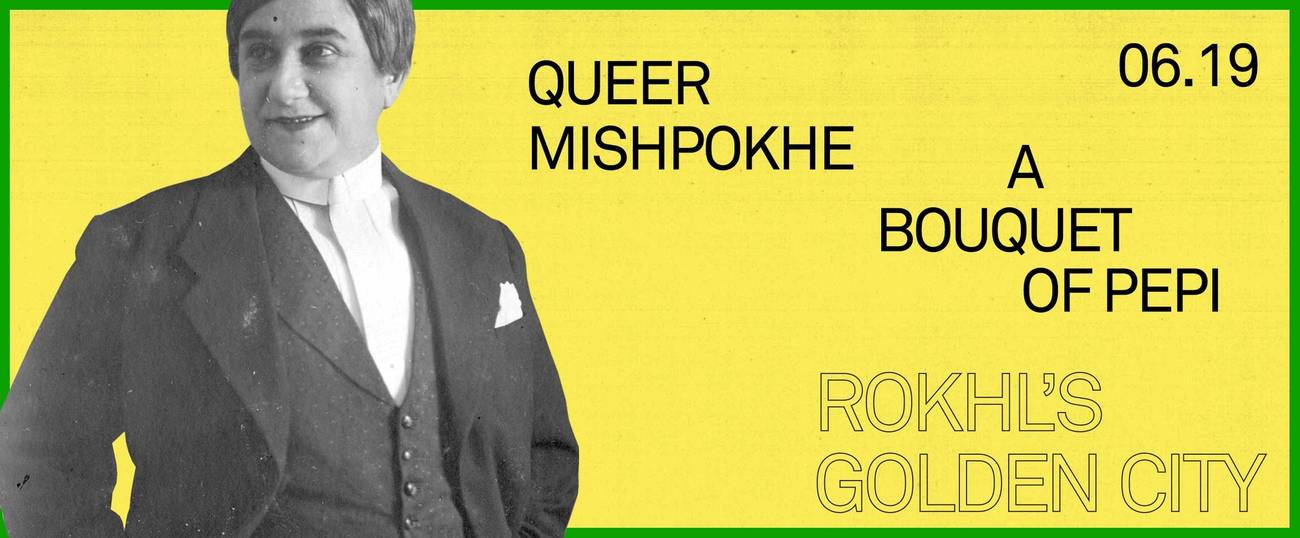Queer Yiddishkeit
Rokhl’s Golden City: Finding a home in Yiddishland while challenging the status quo




I recently saw The Dybbuk for the first time in quite a few years, and for the first time ever on the big screen. I was anticipating the well-known homoerotic subtext. I wasn’t anticipating the peeping in a gay bathhouse, slap you in the face, text-text.
As you may recall reading in these pages, Kino Lorber recently announced the restoration of a number of Golden Era Yiddish films, including the new print of The Dybbuk I saw at Film Forum.
In the town where The Dybbuk is set, the mikve (ritual bath) happens to have a street-facing window, with no curtain. This comes in handy when the young Kabbalist, and thwarted groom, Khonen, heads to the mikve after being chastised by his friend for, well, spending too much time at the mikve. Khonen’s many trips to the mikve are part of his attempt to purify himself, to reach a higher spiritual level, one that, paradoxically, will gain him two barrels of gold and make him a suitable match for his long-ago promised bride, Leah.
Unbeknownst to Khonen, his friend has followed him to the mikve. In a sequence fit for an undergraduate seminar on Freud and cinema, Khonen’s friend brings his face to the mikve window, which is white with steam. Khonen may be up to no good, but we, the viewers, invading his privacy for our own voyeuristic pleasures, are no better. Khonen’s friend brings the camera’s eye right to the window, as our proxy.
Suddenly the steam dissipates and we see the bare face and upper body of Khonen, his eyes closed, one arm folded to his forehead, one arm somewhere off camera, as he shokels gently. It’s the kind of sly composition that anticipates Andy Warhol’s infamous black-and-white films by three decades. In one short sequence, director Michał Waszyński, a gay, Jewish convert to Catholicism, encrypts and aestheticizes Yiddish homosocial erotics for whoever might choose to look for such a narrative. The fact that I can do so, immediately, easily, speaks to how I’ve benefited from the work done in my community, years before I even knew how to ask a Yiddish question.
Scholar Jeffrey Shandler identifies the act of decoding submerged queer narratives as an emblematic act of what he calls queer Yiddishkeit. That is, queer Yiddishkeit is a postwar phenomenon, one in which artists have juxtaposed queerness and Yiddish “as a means of challenging some cultural status quo.” In this framework, Yiddish is analogous to queerness, rebuking hegemonic certainties and persisting aftselakhes (out of spite). The twinned alterities have proven remarkably productive. An early Klezmatics album was called Shvaygn iz Toyt (Silence Is Death), riffing on the ACT UP slogan “Silence = Death.” Three decades later it remains as a powerful statement on the potential of the queer and Yiddish to reinforce each other, at a political and artistic level.
As Shandler notes, many artists and participants in Yiddish cultural spaces arrived there via the entry point of queer Yiddishkeit. He quotes performance artist Sara Felder, who wrote in 1997 that “queer Yiddishkeit gives me permission to go back to the world of my grandparents without leaving myself behind.” Klezkamp, and many of the most important Yiddish cultural spaces today, have been built by queer artists and scholars, many of whom felt empowered to return to Jewish spaces not defined by the heteronormativity, and homophobia, of traditional Judaism.
Queer Jews have flocked to Yiddish cultural spaces and new generations continue to arrive. In a 1997 article for Davka magazine, Alisa Solomon wrote wryly of missing out on Klezkamp. “You shoulda been there,” a friend gushed to her, “It was crawling with queers! We were everywhere.” In 2017, an article on the Yiddish Book Center Steiner Summer appeared called “Seeking and Queering Utopia.” For years, queer students in the program have outnumbered the unqueer. The authors of the article, Tova Benjamin and Noam Green, express the same surprise as Solomon’s friend 20 years prior: Why have all the queers shown up?
It certainly isn’t because Yiddish itself is especially welcoming. The birth of Yiddish literature is tied to the presumption of a female reader and the shaming of male readers for being like women. A 1596 work of musar (ethical literature) carries the warning: “The book was written in Yiddish for women and men who are like women …” It was a shameful thing for a man to be like a woman, unable to study religious works in Hebrew. One of the early names for the Yiddish language was vaybertaytsh, women’s translation.
There is still a fundamental tension between the Yiddish language and our modern notions of gender and sexuality. Take a very simple example. In Yiddish, a Jew is a Yid. A person is a Yid, as in the greeting, vos makht a Yid? (How is a Jew?) The problem is, “a person” is always male. Where a mentsh (a human being) can refer to a man or a woman, a Yid is always a man. As Michael Wex notes, the verb yidishn, to make someone a Yid, refers to circumcision. There’s a feminine version of Yid, of course. It’s Yidene. And it’s exclusively used as a pejorative. Wex suggests more positive terms for a Jewish woman, like yidishe tokhter or yidishe kind, but the bottom line is, “In Yiddish, the Jewish man is; the Jewish woman is described.”
The exclusion of “woman” from the basic Yiddish conception of Jew is pointed and inescapable, and, for the modern person, presents a seemingly irresolvable illiberalism at the heart of our cultural project. Perhaps Shandler would say that the queer Yiddishkeit he describes is a phenomenon of post-vernacularity. The failure of Yiddish to have evolved along with the Jews is beside the point; the creative spark of queer Yiddishkeit comes from the tension between the two worlds.
Or perhaps there is yet another way into queer Yiddish life? Perhaps it might also be through the archives and through the mediation between generations?
When I asked my friend, archivist Chana Pollack, what queer Yiddish life meant to her, she shared the multilayered story of how she met her partner, Myra Mniewski, in 2003. Pollack had just made an incredible find in the Forverts archive, a trove of images of legendary Yiddish drag king, Pepi Litman (1874-1930). In anticipation of their date, Pollack made a mobile out of Pepi image transparencies, and brought it to Mniewski, presenting them with “a bouquet of Pepi.”
At this point I insert myself again, the nonqueer Yiddishist pronouncing on queer Yiddish. My life has been enriched immeasurably by the work of my queer colleagues in Yiddishland, as well as by their friendships. As a single, straight, childless woman of a certain age, I have benefited from the example set by queer folks in reconceptualizing Jewish continuity and Jewish family.
Indeed, upon asking what queer Yiddish meant to them, I received the following from Mniewski, Pollack’s partner and the other half of my new favorite Yiddishland celebrity couple: “There’s a very Jewish seeming LGBTQ saying: An army of ex-lovers cannot fail. We make mishpokhe out of ex-lovers, we make mishpokhe out of current lovers, we make mishpokhe period. So, it’s natural for us to seek out connections between the seemingly unconnected, disconnected, fringe dwelling and of course of course of course the despised. Yiddish is still despised, fringe-dwelling, and rejected. Hence its queer mishpokhe nature. When I translate Yiddish, I am amongst mishpokhe. And I too am found.” Omeyn.
LISTEN: My dear friend Miryem-Khaye Seigel has been composing wonderful new Yiddish songs that reflect her life as a queer woman in New York. You can hear her sing her song “Di bahaltene libe” (The Hidden Love) here.
READ: Two books by Naomi Seidman are crucial for thinking about the gender politics of Hebrew and Yiddish as well as the queerness of Ashkenaz: A Marriage Made in Heaven: The Sexual Politics of Hebrew and Yiddish and The Marriage Plot: How Jews Fell in Love with Love and with Literature.
WATCH: In 2005 Canada made same-sex marriage legal. That year, key figures in queer Yiddishkeit, including Sara Felder, Adrienne Cooper, and Lorin Sklamberg, presented a historic concert in Toronto called Queer Jewish Weddings. It’s a joyous fusion of the very personal and political.
MORE: The unpredictable and genre-busting duo of Jewlia Eisenberg and Jeremiah Lockwood are back in NYC! They’ll be doing a residency at Barbes in Park Slope, every Saturday night in July … If you’re lucky enough to be near the Pioneer Valley, this year’s lineup for Yidstock, the Yiddish Book Center music and lectures festival, is off the hook. Stuff is selling out, so get tickets now. July 11-14, Yiddish Book Center, Amherst, Mass. … If you’re the kind of person who summers in the Hamptons, I hope you’ll go to the Southampton Jewish Film Festival to check out this new mock(?)-umentary called HAG (The Hasidic Actors Guild). July 23, 7:30 p.m. … YIVO just announced a new addition to their famed intensive Yiddish summer program, open to the public! It’s called the Yiddish Civilization Lecture Series and features the top scholars in the world. June 24-July 29 … Finally, please enjoy the unofficial anthem of queer Yiddish, Ale Brider.
***
Like this article? Sign up for our Daily Digest to get Tablet magazine’s new content in your inbox each morning.
Rokhl Kafrissen is a New York-based cultural critic and playwright.